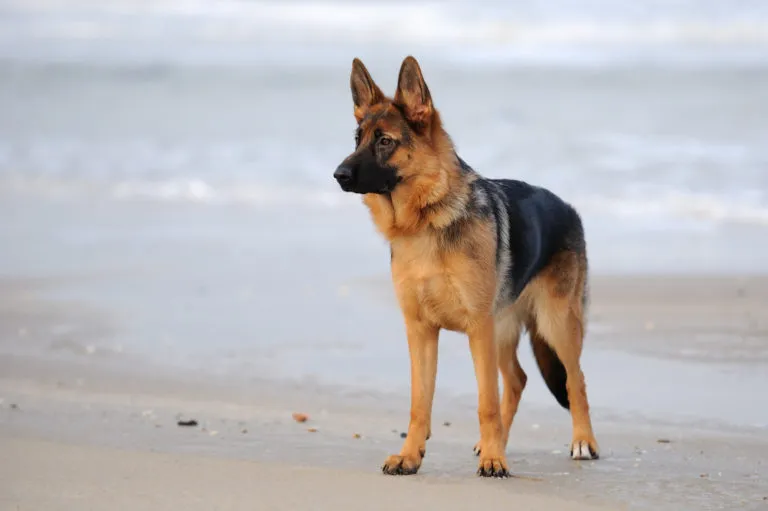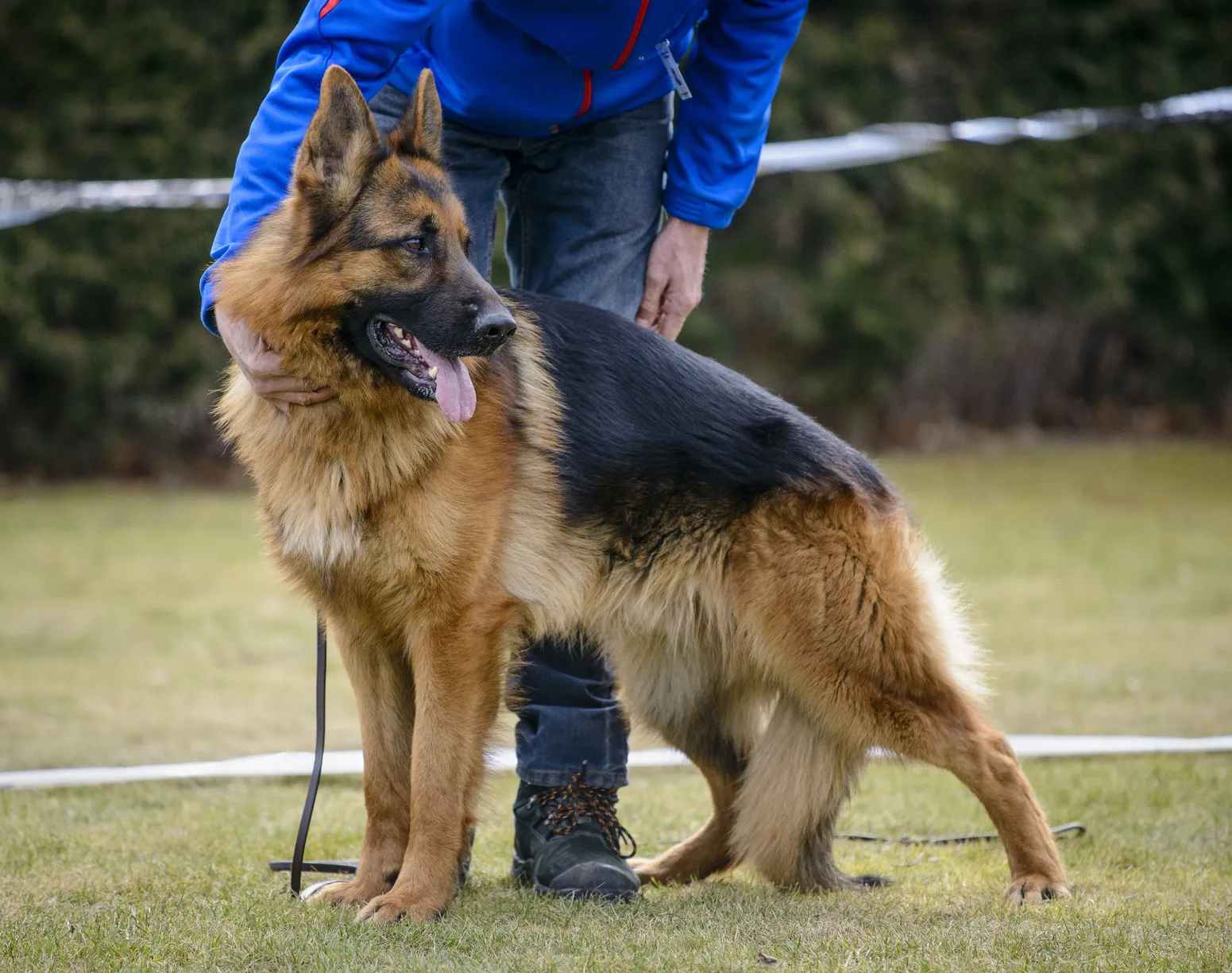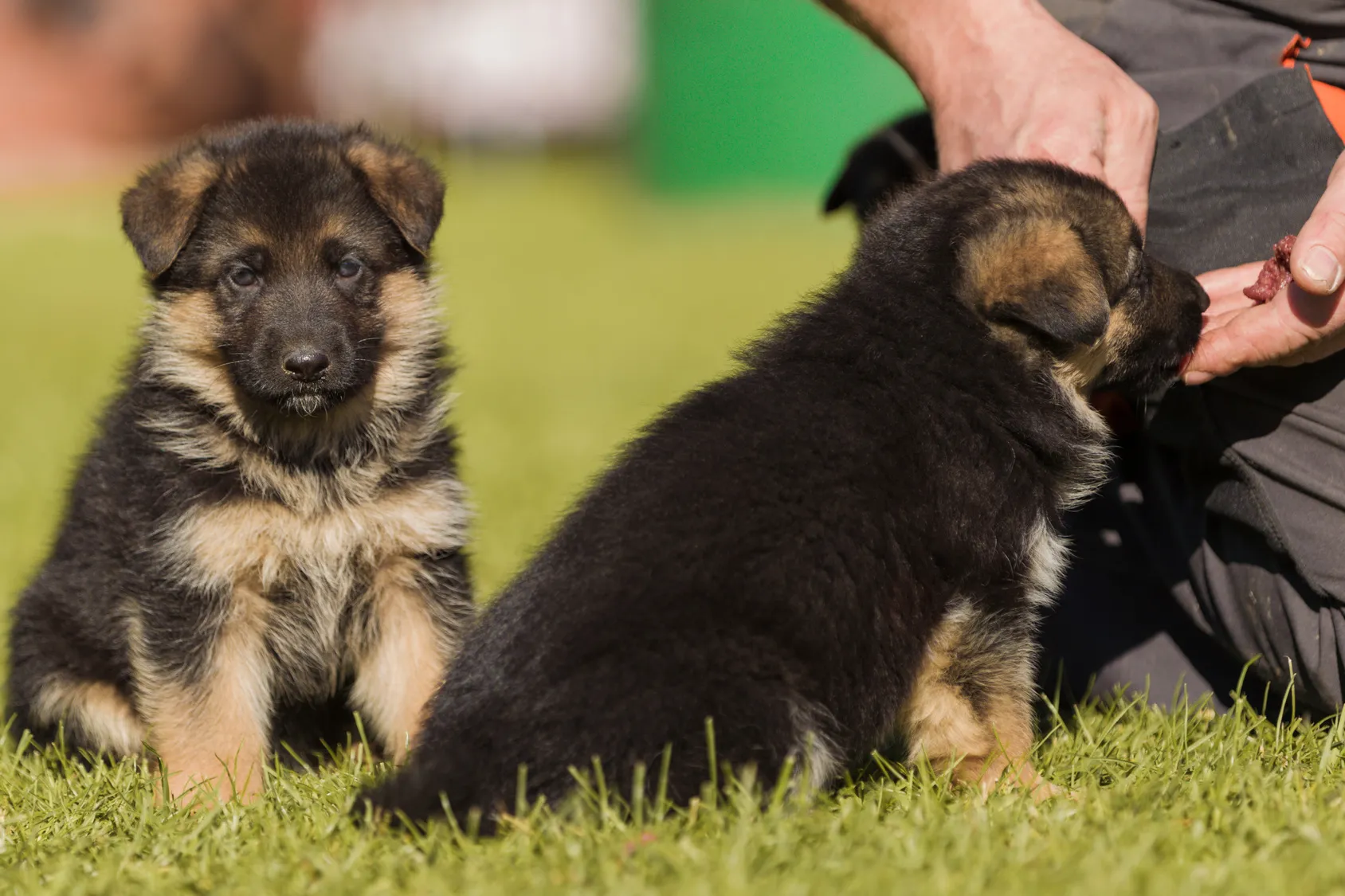Medium Size Poodle
German Shepherd Dogs are the most widespread working breed in the world, but thanks to their eagerness to learn and human-loving nature, these versatile dogs also make for a great family pet.

Despite its old-school appearance, the German Shepherd is a new breed of dog.
Hardly any other pedigree breed is as versatile as the German Shepherd. Originally bred as a herding dog that could guard the sheep, the German Shepherd is now used as a service and protection dog by the police, military and customs, as well as making great rescue dogs, therapy dogs, avalanche search dogs and guide dogs. The German Shepherd is the leading service dog breed, not only in its native Germany but worldwide!
The German Shepherd is confident, robust and easy-going. No man or machine can replace this courageous, persistent and reliable dog at its work! Its drive behaviour, resilience and self-assurance are legendary features of the breed. Thanks to its high intelligence, ability to learn and enormous willingness work means this breed accepts new challenges at lightning speed and is suitable for practically any task given to it. The German Shepherd is also a very human-related breed, remaining true, loyal and reliable for its owner. It is this winning combination of robustness, drive, reliability and easy-going nature that makes this breed so popular and destined to be used in such a wide variety of areas.
Its loyalty and reliability has made the German Shepherd an extremely popular family dog. This breed does in fact make a great partner and companion, especially when well-trained and kept busy, making it well-suited to living together with a family. Well-socialised German Shepherds are fond of children and live happily alongside other pets. However, a prerequisite for keeping this breed as a family pet is that this active breed is kept both physically and mentally stimulated. Dogs that are not kept occupied, without their need to move and work being taken into account, can quickly develop bad habits, which are a foreign concept to a well-balanced pedigree dog. They can also become nervous and watchful, making them difficult to control in everyday life. German Shepherds that are kept physically and mentally challenged are a true asset to any family, making a great playmate, sports buddy and incredibly loyal protector.

With a shoulder height of between 60-65cm in males and 55-60cm in females, the German Shepherd is classified as a medium to large breed. Its well-proportioned body plays an important part in its use as a working and service dog. This breed is strong and well-muscled, but with an athletic and agile appearance, and rarely having a tendency to be clumsy. It has a strong, long gait that is vital in its great endurance.
The wedge-shaped head sits in harmony with the body, ending with a straight bridge of the snout and a black nose. It has an impressive complete set of 42 teeth, with upright, forward-facing ears and dark, slightly slanting eyes that give the German Shepherd a watchful and attentive expression.
For a long time, the breed standard of the FCI (World Dog Club) only accepted dogs with a double coat, with the German Shepherd Dog being listed under number 166 in the working and herding dog groups. The double coat should be straight and firm, reinforced by a dense undercoat that offers reliable protection from snow, rain and cold.
It was only in 2008 that the longer-haired variety of this breed was included in the FCI standard. Its long, soft top coat does not sit tightly to the body in this breed variety, instead forming bushy feathers on the ears, legs and tail. A characteristic mane should also be visible on the neck. Coat fur can be black with brown, yellow or light grey markings, black or wolf-grey monochrome or grey with brown markings.
Although occasional litters will have white German Shepherd puppies, the FCI standard does not accept white as a colour and has not done since 1933. In 1968, the “Shepherd Dog Club of America”, who is responsible for the “American Kennel Club” standard, also followed suit. The only exception today is the “Canadian Kennel Club”, which still allows white Shepherd Dogs on its breed books. Since 2011, the FCI has classed the white Shepherd Dog as an independent breed under the name “White Swiss Shepherd Dog”. However, white German Shepherd puppies may not be mated with the Swiss dogs, and so cannot be registered as such.
Over the course of its breeding, the German Shepherd has become bigger and bigger. Critics complain that this shape has very little in common with the original Shepherd Dog, which was a lot lighter, less muscular and much more agile. This dispute among breeders has led to the fact that today there are two distinct lines of breeding. One line focuses on beauty breeding, with larger physique and a sloping back, whilst the other line is based on performance, preferring a lighter type and with emphasis on good service dog characteristics.
The ancestors of the German Shepherd Dog are thought to have lived in Germany in the 7thcentury. These double-coated dogs already had a wide range of tasks, including their main job of herding and driving flocks of sheep as well as guarding and protecting the shepherd’s possessions.
However, the history of the German Shepherd as we know it today only officially begins at the end of the 19th century. In 1871, the Prussian court rider Max von Stephanitz began the purposeful breeding of these versatile dogs and is today considered to be the founder of this breed.
Stephanitz had great success with his dog “Hektor von Linksrhein”, whom he renamed “Horand von Grafrath” after his purchase in 1898. Horand was the first dog to be registered in the studbook of the newly founded “Association for German Shepherd Dogs”. Stephanitz put all of his breeding efforts into him and to his brother “Luchs von Sparwasser”. Horand von Grafrath, Luchs von Sparwasser and the bitch ”Mari von Grafrath” are today considered to be the original parents of the German Shepherd Dog. Most German Shepherd Dogs today can be traced back to their lineage.
The goal of Stephanitz’s breeding was clearly defined. He was interested in a versatile working dog, with precise ideas about its nature and working characteristics. Its virtues of courage, loyalty, obedience, endurance and robustness made the German Shepherd world-famous and, in many countries, one of the most popular service dog breeds for authorities such as the police and the military. During the First and Second World Wars, these qualities were stylised into “German values”, becoming a symbol for National Socialism. In the wake of anti-German sentiment abroad, the British Kennel Club changed the breed name to the “Alsatian Wolf Dog”, or later simply the “Alsatian”, to bypass the need for “German” in the name. It was only in 1977 that the name change was reversed.
Nevertheless, the German Shepherd Dog was a popular war dog for the Allies as well as the Germans, although it gained notoriety for its use in concentration camps and as a loyal companion to Adolf Hitler. Numerous Nazi propaganda photographs show Hitler with his German Shepherd Dog “Blondi”. Despite this association and a strong decline in popularity during the Second World War, the breed was able to prevail after the war and soon became, once again, one of the most sought-after dog breeds in the world. With the role change of many dog breeds from working dogs to family dogs, the German Shepherd Dog became an increasingly popular choice as a family pet.
Unfortunately, as the breed became more popular, the number of breed-related diseases also increased. For example, hip dysplasia (HD) was first diagnosed in the German Shepherd Dog and is now seen in many dog breeds. Another joint disease the breed struggles with is elbow dysplasia (ED), as well as degenerative lumbosacral stenosis (DLSS) or “cauda equina syndrome”, which leads to paralysis. In addition, there are many eye diseases and allergies that commonly occur in German Shepherds.
Healthy puppies are not available for a bargain price. Genetic tests of breeding animals are intended to reduce the occurrence of hereditary diseases, and “breeding values” provide information about the extent to which a puppy is pre-disposed to a diseases. Dogs that are genetically predisposed will be excluded from breeding. If you are interested in a German Shepherd puppy, you should check that all recommended tests have been carried out and passed. To ensure that this has taken place, you need to buy from a reputable breeder who invests a lot of time and money into the health of his or her dogs and will willingly give you any information you ask for. It goes without saying that an all-round healthy and monitored puppy can only be bred and obtained at a substantial cost. However, compared with other dog breeds, pedigree German Shepherd puppies are relatively affordable.

Before choosing a breeder, you should know exactly what it is you are looking to get from your German Shepherd Dog. Most breeders will now specialise in different lines, promoting different characteristics in their breeding animals, such as a strong urge to work. You should ask in advance whether the breeder focuses more on beauty or performance and choose the kennel that best suits your needs. Be aware, however, that even a dog chosen as a family pet and bred based around beauty standards will still have a strong desire to learn and work, and will not be content with short walks around the block.
Your dog’s activity levels will affect the type of food you need to provide. Naturally, a dog that works for several hours a day and is always on the move will have different energy needs from a family dog that spends much of its day resting. The basic rule for dog food, however, is that it must be rich in protein, minerals and vitamins to ensure healthy development. The dog’s most important source of protein is meat, which should make up around 70% of its diet regardless of the food type you choose, whether that be ready-to-eat food, home-cooked meals or raw feeding. A fruit and vegetable content of around 20-30% is also recommended to provide your dog with the important vitamins and minerals it needs. Too much grain or sugar should be avoided as they do not form part of a healthy canine diet.
Discover our selection of German Shepherd food in our zooplus Dog Shop!
As German Shepherd Dogs are prone to joint problems, like many large breeds, it is important to prevent your puppy from growing too quickly in the first few months of life. Studies show that hip dysplasia can not only be caused by a genetic predisposition, but also by the nature of feeding. A diet with too much energy and too many fats can accelerate the already rapid growth of a young puppy and cause joint problems even in old age. Let your breeder provide an exact feeding recommendation and pay attention to it, offering your dog an appropriate puppy diet. The breeder will also advise you not to overwhelm your puppy with too much exercise. Avoid the stairs completely until your dog is fully developed and allow natural rest periods to support healthy bone and joint development.
As well as a balanced diet and species-appropriate outlook, a healthy canine lifestyle also requires you to provide proper care for your dog. The double coat is fairly easy to care for, but regular brushing is required to keep the coat structure healthy. Regular worming, parasite prevention and vaccinations are also essential, and you should check your dog’s claws, eyes and ears regularly. If you notice any changes, be sure to visit your veterinarian, and make regular appointments for a general check-up.
If you decide to include a German Shepherd Dog in your family, you will first of all need to think about how to look after it, as well as care and diet. German Shepherds are first and foremost working dogs and as such will want to be “used” within a family. Sufficient physical and mental stimulation is essential if you are to live harmoniously with your German Shepherd. As the owner of a German Shepherd, you will need to be interested in taking long walks or bike rides with your dog, as well as looking to get your dog involved in learning a form of dog sport or training that keeps it entertained.
Thanks to its versatility, the German Shepherd Dog delights in almost all dog sports, including agility, dog dancing and obedience. Its outstanding senses also make this breed perfect for tracking. It is recommended to train this dog up as a rescue dog, guard dog, gun dog or service dog, even if it is intended as a family pet. Regardless of which sporting activity you choose to get your dog involved in, there will be positive consequences for the relationship between the two of you and your dog will remember them! Dogs that are sufficiently exercised, both physically and mentally, not only enjoy rest and recovery phases more than other dogs, but are also more receptive to training. Those will the time to keep their German Shepherd trained and fit will be rewarded with a very kind, sporty, easy-going and loyal family dog.
Fans of the Bearded Collie agree that those who aren't familiar with this dog breed simply have to get acquainted with it. And those who have experienced how a Bearded Collie bolts across meadows with its flowing fur, how it rolls around full of energy and joy and how it attentively and observantly takes into account its owners wishes become simply addicted to this original dog breed and its unique charm.
The Goldendoodle isn't a breed, but a pairing between Golden Retrievers and Medium or Standard Poodles. Marketed as a low-maintenance dog for allergy sufferers, this hybrid is enjoying increasing popularity amongst dog lovers, similar to the Labradoodle.